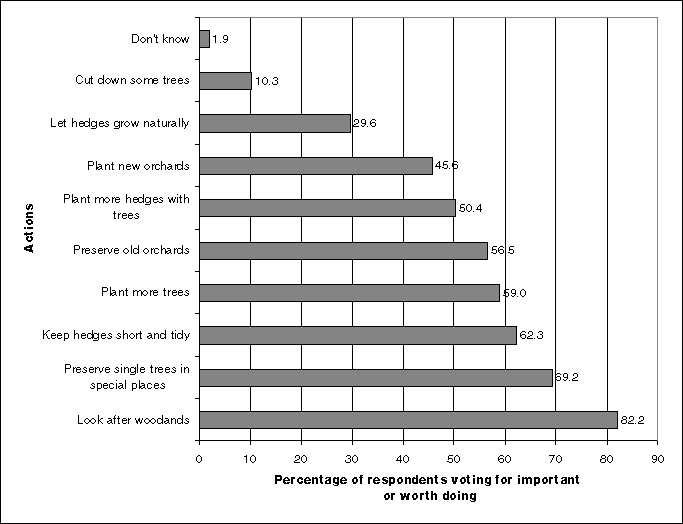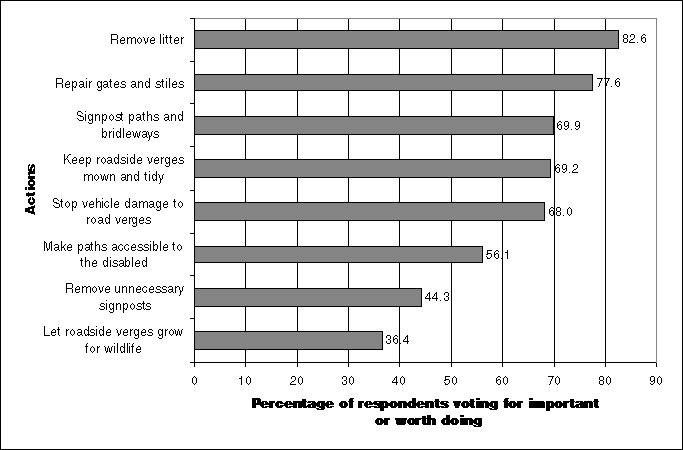Environment
As seen in the high proportion of people coming to live in
Ropley because of its attractiveness, its landscape is a major asset and the
most fragile. Conserving this, whilst allowing for the inevitable use of the car
and its associated problems of safety and parking congestion, is perhaps the key
issue underlying the concerns raised by the questionnaire.
Though many hedges and trees have been lost in the process of
farms merging into larger units the parish is still well wooded overall, with
many smaller copses and smaller fields, and an excellent network of footpaths,
making it attractive walking country. There is a good spread of wildlife, with
badgers, foxes and numerous deer. Indeed if you compare the village today with
old photographs of 50-80 years ago itís striking how its appearance has
improved, thanks to tree planting and preservation efforts by villagers through
the century.
In carrying out an environmental "audit" on Ropley
there are various positive factors:
 |
A large area, of 3700 acres, including a lime quarry,
farm ponds, ducks, and extensive wildlife. |
 |
There is substantial underground water, measured and
monitored by the River Authority, though this is siphoned off to supply the
rivers under their management. |
 |
The gas and oil pipelines pass underground (but donít
service the village). |
 |
Thereís a very good network of footpaths, bridleways,
green lanes; see Ropley Footpaths book, reprinting next year. |
 |
Open space; recreation ground. |
 |
Farmers currently use new generation chemicals that break
down quicker, leaving fewer residues, which helps wildlife. |
 |
Two Conservation Areas. |
 |
No large woodland feature. |
 |
Electricity/telephone poles an eyesore in many areas,
particularly in the conservation part of the village. The Ropley Society
campaigned for some years to have these put underground, but the momentum
was lost. |
 |
Colonial buildings nearly all gone, creating suburban
rather than rural feel. |
 |
Road names lacking, Hammonds Lane, Maddocks Hill,
Vicarage Lane, Church St |
 |
Litter a problem, particularly generated by the young
coming from school buses, also fly tipping in farmersí gateways and fields |
When asked what should be done to help protect the
environment, 62% of respondents identified recycling as the main action. The
second priority was for an improvement in public transport but there is little
evidence from the questionnaire that people are prepared to use it. A similar
situation is expressed by 35% of the people with the desire to reduce traffic,
whereas the all-round use of the car seems likely to increase. There was also
general support (approx 25% of the respondents) for improved rights of way,
energy saving and more local employment.
Recent government legislation to protect hedgerows and other
countryside amenities struck an accord with the wishes of the majority of the
village with 70% of the 300 respondents expressing a willingness to help with
the protection of wildlife habitats and 200 offering their services to maintain
footpaths.
When asked what landscape features should be protected, 650
(80%) voted for hedges and ponds. These were closely followed by trees, open
spaces and banks.

Actions to improve the environment
A high number of people (844) answered questions on improving
the environment of Ropley and on roads, lanes and paths to make the countryside
more attractive. Analysis is almost impossible, the tables show the support for
each action and allow the reader to make their own judgement.

Actions to make the countryside more attractive
When asked what disturbances do the residents of Ropley
suffer from the answers were somewhat surprising with 48% of people complaining
of low flying aircraft and 34% by microlights. Analysing the location returns
shows that the highest number of complaints are from the outer areas of the
village. Traffic noise is the next biggest offender with houses near the A31
Winchester Road being affected most.
Whilst not yet a major problem for the village as a whole (17% complained),
this is more likely to worsen in the future as the pressure to urbanise the
village grows.


